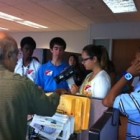Work by High School Campers
Urban Teachers Paid Less, Face More Challenges
|
On average, teachers in the state’s three cities Hartford, New Haven and Bridgeport earn about $3,000 to $5,000 less than teachers working in suburban schools – because cities don’t have the funding resources. Sharon Palmer, the president of the American Federation of Teachers, whose union represents the cities’ teachers and others, said that another reason for the compensation gap is that the state of Connecticut has not fulfilled its funding commitment to support schools in cities and towns. For years, cities and towns have lobbied the state General Assembly for full funding for education, as a way to boost teacher salaries and provide incentives to keep teachers working in urban districts. But the mandate has never been met. According to new teacher contract data, a first-year teacher with a bachelor’s degree earns about $42,000 a year in the three big cities compared with a starting teacher in Greenwich, Darien and Westport, whose entry-level pay ranges from $45,000 to $51,000.









